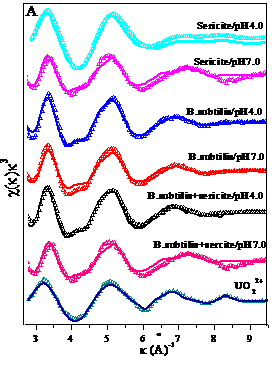
count: [2016-05-06] [Close]
Dr Yubing Sun, a researcher from Plasma Application Division, ASIPP has been investigating the environmental factors, i.e., reaction time, pH, ionic strength and initial concentration, on the physicochemical behaviors and micro-structures of radionuclides at water-solid interfaces by using batch, synchrotron X-ray absorption spectroscopy (XAS) and surface complexation modeling, to achieve better understanding of Transports of Radionuclides at Water-mineral-microbe Ternary Systems.
Sun and his partners studied the interaction mechanism between U(VI) and sericite in the presence of microbes at the molecular level by batch adsorption, synchrotron radiation technique (EXAFS) and surface complexation modeling. They found that the microbes (Bacillus subtilis) facilitated the adsorption of U(VI) on sericite at pH < 5.0, whereas the decreased adsorption of U(VI) was observed at pH > 6.0 due to the strong complexation of deprotonated carboxyl groups of Bacillus subtilis and sericite. According to EXAFS analysis, U(VI) tended to combine with phosphoryl groups of bacillus subtilis at low pH, while U(VI)-carboxyl complexes were demonstrated at near-neutral pH conditions.
Since the Fukushima accident in 2011, the possibility of harm to ecological environment and human health caused by radioactive pollution has aroused wide public concern. Uranium is likely to be released into the environment during the mining, processing and transport process, resulting in radioactive pollution. It is important to understand how uranium is transported and transformed on earth surface in order to assess its impact on environment and human health.
In the past, researches used to focus on the effect of different environmental conditions on U(VI) at water-mineral interface absorption. However, few studies concerning the effect of microbes on the adsorption of radionuclides at water-mineral interface are available.
Dr Sun’s observations play an important role in understanding the fate and transports of radionuclides at water-mineral-microbe ternary systems. (Wang Ying and Sun Yubing report)
Article links: http://www.sciencedirect.com/science/article/pii/S0016703716300503.


EXAFS spectra (A) and their corresponding Fourier transform (FT) (B) for U(VI)-containing sericite, B. subtilis and sericite+B.subtilis